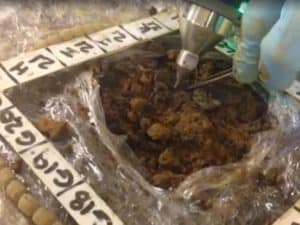 The last coins from an ancient Celtic hoard discovered in a field in Jersey have been successfully removed from the dirt they were buried in.
The last coins from an ancient Celtic hoard discovered in a field in Jersey have been successfully removed from the dirt they were buried in.
Known as Catillon II and dating from around 30-50 BC, the collection of nearly 70,000 coins was six times larger than any other similar Celtic artefacts and also included jewellery, beads and fabric.
The find was so extensive that historians speculated it could change the way the Celts are viewed.
Estimated to be worth at least £10m, the hoard was discovered in 2012 by Reg Mead and Richard Miles, who spent 30 years digging in the field because of a hunch.
Archaeologists from Jersey Heritage, the Société Jersiaise and Guernsey Museum later excavated the site.
They were able to successfully remove the Iron Age hoard from the ground in one piece – a difficult operation, given the hoard was made up of thousands of coins which had stuck together in the dirt over the centuries.
They are believed to have been buried by the French Celtish Curiosolitae tribe, possibly as they fled a Roman invasion.
The hoard also contained gold torque neck clasps, worn by high ranking members of the tribe. Glass beads and a leather bag and bag woven with silver and gold were also found hidden within the coins.
Neil Mahrer, who has led the conservation project from the beginning, said: “This is a significant milestone for the team. It has been painstaking but thoroughly intriguing work, which has delivered some very unexpected and amazing finds along the way.
“There is still plenty to do and I am sure the hoard will continue to surprise us as we clean and record the material.”
The coins themselves have been found scattered though out the area they were found in, but never in large amounts.
Looking for their source became a hobby for Mr Mead and Mr Miles, who searched for it with their metal detectors since their twenties.
“There was something there that drew us to it,” Mr Miles told the BBC. “Every Sunday, we would give it a try. I found the first coin – and by the end of the first day we found 20 coins.”

